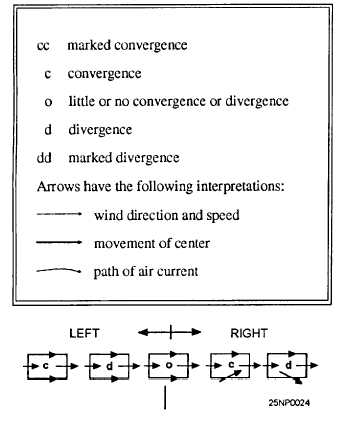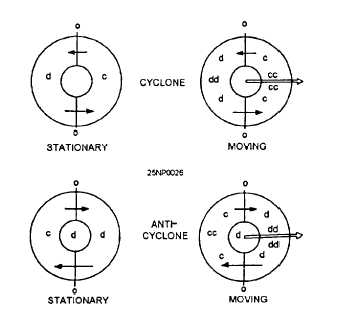Frontal Lifting
Frontal lifting is the term applied to the process
represented on a front when the inclined surface
represents the boundary between two air masses of
different densities. In this case, however, the slope
ranges from 1/20 to 1/100 or even less. The steeper the
front, the more adverse and intense its effects, other
factors being equal. These effects were discussed in
detail in the AG2 TRAMAN, volume 1.
Vertical Stretching
Since it is primarily from properties of the
horizontal wind field that vertical stretching is
detectable, it is more properly called convergence. This
term will be used hereafter.
The examples of convergence and divergence,
explained in the foregoing, are definite and clear cut,
associated as they are with the centers of closed flow
patterns. Less easily detected types of convergence and
divergence are associated with curved, wave-shaped, or
straight flow patterns, where the air is moving in the
same general direction. Variations in convergence and
divergence are indicated in figures 4-1, 4-2, 4-3, and 4-4
by means of the following key:
Figure 4-2.-Convergence and divergence in meridional flow.
The left side of figure 4-1 illustrates longitudinal
convergence and divergence; the right side illustrates
lateral convergence and divergence. Many more
complicated situations can be analyzed by separation
into these components.
It can be shown mathematically and verified
synoptically that a fairly deep layer of air moving with
a north-south component has associated convergence or
divergence, depending on its path of movement. In
figure 4-2 the arrows indicate paths of meridional flow
in the Northern Hemisphere. In general, equatorward
flow is divergent unless turning cyclonically, and
poleward flow is convergent unless turning
anticyclonically.
The four diagrams of figure 4-3 represent the
approximate distribution of convergence and
divergence in Northern Hemispheric cyclones and
anticyclones.
For moving centers, the greatest
convergence or divergence occurs on or near the axis
along which the system is moving. The diagrams of
figure 4-3 show eastward movement, but they apply
regardless of the direction of movement of the center.
Figure 4-1.-Longitudinal and lateral convergence and
divergence.
Figure 4-3.-Convergence and divergence in lows and highs.
4-2





